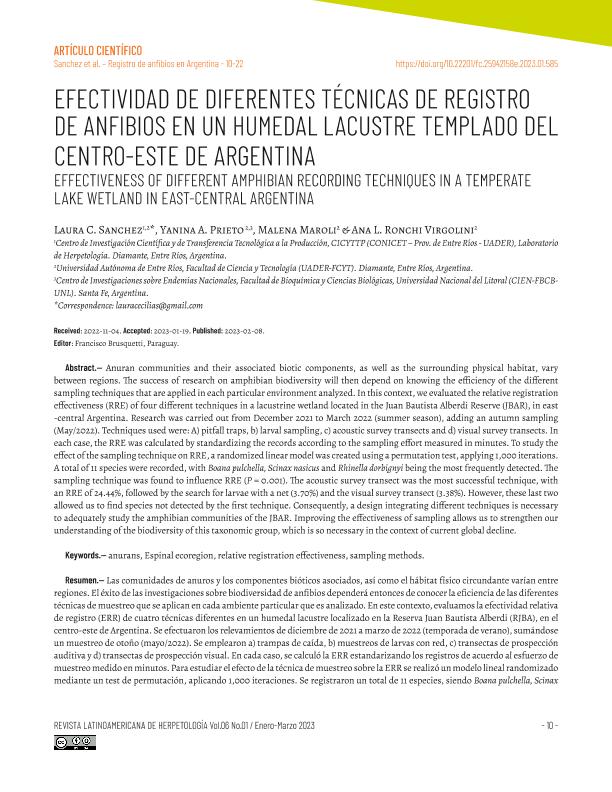Artículo
Las comunidades de anuros y los componentes bióticos asociados, así como el hábitat físico circundante varían entre regiones. El éxito de las investigaciones sobre biodiversidad de anfibios dependerá entonces de conocer la eficiencia de las diferentes técnicas de muestreo que se aplican en cada ambiente particular que es analizado. En este contexto, evaluamos la efectividad relativa de registro (ERR) de cuatro técnicas diferentes en un humedal lacustre localizado en la Reserva Juan Bautista Alberdi (RJBA), en el centro-este de Argentina. Se efectuaron los relevamientos de diciembre de 2021 a marzo de 2022 (temporada de verano), sumándose un muestreo de otoño (mayo/2022). Se emplearon a) trampas de caída, b) muestreos de larvas con red, c) transectas de prospección auditiva y d) transectas de prospección visual. En cada caso, se calculó la ERR estandarizando los registros de acuerdo al esfuerzo de muestreo medido en minutos. Para estudiar el efecto de la técnica de muestreo sobre la ERR se realizó un modelo lineal randomizado mediante un test de permutación, aplicando 1,000 iteraciones. Se registraron un total de 11 especies, siendo Boana pulchella, Scinax nasicus y Rhinella dorbignyi las detectadas con mayor frecuencia. La técnica de muestreo influyó en la ERR (P = 0.001). El transecto de prospección auditiva resultó la técnica más exitosa, con una ERR del 24.44%, seguida por la búsqueda de larvas con red (3.70%) y el transecto de prospección visual (3.38%). No obstante, estas dos últimas permitieron encontrar especies no detectadas con la primera. Consecuentemente, un diseño integrando diferentes técnicas es necesario para estudiar adecuadamente las comunidades de anfibios de la RJBA. Mejorar la efectividad de los muestreos permite fortalecer nuestra comprensión sobre la biodiversidad de este grupo taxonómico, tan necesario en el contexto de declinación global actual. Anuran communities and their associated biotic components, as well as the surrounding physical habitat, vary between regions. The success of research on amphibian biodiversity will then depend on knowing the efficiency of the different sampling techniques that are applied in each particular environment analyzed. In this context, we evaluated the relative registration effectiveness (RRE) of four different techniques in a lacustrine wetland located in the Juan Bautista Alberdi Reserve (JBAR), in east-central Argentina. Research was carried out from December 2021 to March 2022 (summer season), adding an autumn sampling (May/2022). Techniques used were: A) pitfall traps, b) larval sampling, c) acoustic survey transects and d) visual survey transects. In each case, the RRE was calculated by standardizing the records according to the sampling effort measured in minutes. To study the effect of the sampling technique on RRE, a randomized linear model was created using a permutation test, applying 1,000 iterations. A total of 11 species were recorded, with Boana pulchella, Scinax nasicus and Rhinella dorbignyi being the most frequently detected. The sampling technique was found to influence RRE (P = 0.001). The acoustic survey transect was the most successful technique, with an RRE of 24.44%, followed by the search for larvae with a net (3.70%) and the visual survey transect (3.38%). However, these last two allowed us to find species not detected by the first technique. Consequently, a design integrating different techniques is necessary to adequately study the amphibian communities of the JBAR. Improving the effectiveness of sampling allows us to strengthen our understanding of the biodiversity of this taxonomic group, which is so necessary in the context of current global decline.
Efectividad de diferentes técnicas de registro de anfibios en un humedal lacustre templado del centro-este de Argentina
Título:
Effectiveness of different amphibian recording techniques in a temperate lake wetland in east-central Argentina
Fecha de publicación:
02/2023
Editorial:
Sociedad Herpetologica Mexicana
Revista:
Revista Latinoamericana de Herpetología
ISSN:
2594-2158
Idioma:
Español
Tipo de recurso:
Artículo publicado
Clasificación temática:
Resumen
Archivos asociados
Licencia
Identificadores
Colecciones
Articulos(CICYTTP)
Articulos de CENTRO DE INV.CIENT.Y TRANSFERENCIA TEC A LA PROD
Articulos de CENTRO DE INV.CIENT.Y TRANSFERENCIA TEC A LA PROD
Citación
Sanchez, Laura Cecilia; Prieto, Yanina; Maroli, Malena; Ronchi Virgolini, Ana Laura; Efectividad de diferentes técnicas de registro de anfibios en un humedal lacustre templado del centro-este de Argentina; Sociedad Herpetologica Mexicana; Revista Latinoamericana de Herpetología; 6; 1; 2-2023; 10-22
Compartir
Altmétricas




